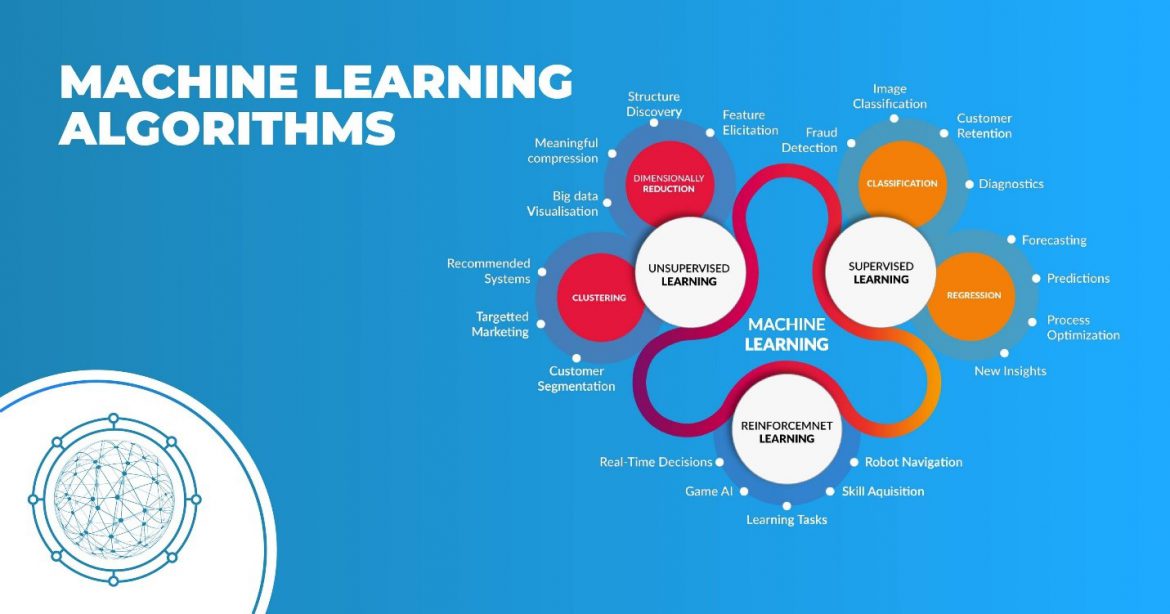Table of Contents
Discover the Machine Learning Algorithms 2021
The ability to make accurate outcome predictions by a software application is the power that can only be enabled by the use of Machine Learning. Machine learning algorithms today are not like the ones of the past. Being born from a mere theory, computers can learn to perform a certain task without being specifically programmed. The iterative aspect is essential as models are regularly exposed to new types of data to adapt to independently. They learn from previous computations to produce efficient results and predictions.
While many machine learning algorithms have been around for a reasonably long period, the ability to automatically apply complex mathematical calculations in an efficient and much quicker manner has been a recent development in the world of ML.
What are the algorithms in machine learning
The most basic answer to a commonly asked question is how machine learning gives a machine the ability to predict through Machine learning algorithms. ML uses programmed algorithms that receive data inputs and analyze them accordingly to predict values within an acceptable range. With time, as they are fed with new data, they learn how to improve their performance by optimizing the operations being carried out to achieve a task.
Here are the three basic types of machine learning algorithms that fall under the umbrella of ML
Supervised learning
This type of algorithm emphasizes teaching the machine by example. The machine is provided with a known dataset by the operator that includes desired inputs and outputs. Now it’s the algorithm’s job to find out a method that led to the production by the use of provided inputs. While the operator knows the correct methodology and answers to the problem, it allows the algorithm to figure out ways on its own and then analyses the produced outputs. The operator then corrects the algorithm’s predictions, and this process keeps on going until the algorithm has achieved a certain level of accuracy.
Supervised learning can be subcategorized into three different categories:
Classification:
The ML program must conclude the observed values and determine what category the new observations belong to.
Regression:
In this type of supervised learning, the program must estimate the relationship between different types of variables.
Forecasting:
It focuses on making predictions based on the present and past data. It is commonly used to analyze trends and assume appropriate outputs.
Semi-Supervised Learning:
Being very similar to Supervised Learning, semi-supervised learning makes use of both labeled and unlabeled data. Labeled data is the one that contains meaningful tags so that the algorithm can understand the data; on the other hand, an unlabeled one lacks any prior tags so the machine has to learn to label it on its own. This enables the machine to learn different ways to tackle unknown data types and figure out their categories.
Unsupervised learning:
With no human assistance or instructions, an unsupervised learning algorithm must learn to study the data and identify different patterns. The machine determines the correlations and relationships by critically analyzing the available data and properly structure it.
What are Learning Algorithms
When the term of learning algorithm comes in the broad term of Machine Learning Algorithms, they are the brains behind any model. These algorithms allow the machine to learn and make critical decisions. These algorithms are continuously fed with data and new experiences to improve overall efficiency. These algorithms can often be grouped by similarity in terms of their functionality. However, as much as a useful method this might be, it’s not perfect due to the overlapping categories that some of the algorithms fall in.
Here are some of the most common groups that umbrella several Machine Learning Algorithms:
- Regression Algorithms:
These types of algorithms are concerned with modeling the relationship between variables. Regression methods are linked with statistics and have been integrated into statistical machine learning. Here are some of the most popular Regression Algorithms:
. OLSR (Ordinary Least Squares Regression)
. Stepwise Regression
. MARS (Multivariate Adaptive Regression Splines
. Logistic Regression
. Linear Regression
- Instance-Based Algorithms:
These algorithms deal with examples of training data that are considered essential and required by the model to compare new data with the database and make an efficient prediction. Following are some examples of instance-based algorithms:
. SOM (Self-Organizing Map)
. KNN (K-Nearest Neighbor)
. Learning Vector Quantization (LVQ)
. SVM (Support Vector Machines)
- Regularization Algorithms:
It’s an extension made to Regression algorithms that penalize models critically based on favoring simpler models that are also better at generalizing. These algorithms are powerful, popular, and generally simple. The most popular Algorithms that lay in this category are:
. Elastic Net
. LARS (Least-Angle Regression)
. LASSO (Least Absolute Shrinkage and Selection Operator)
. Ridge Regression
- Decision Tree Algorithms
Decision tree methods are used to construct a model of decisions that are based on actual values of attributes in the data. These algorithms are often fast and the most reliable in Machine learning as they are trained on classification and regression problems. Here are some of the most well-known Decision Tree Algorithms in machine learning algorithms:
. CHAID (Chi-Squared Automatic Interaction Detection
. ID3 (Iterative Dichotomiser 3)
. Decision Stump
. M5
. CART (Classification and Regression Tree)
Best Machine Learning Algorithm
Among the never-ending list of Machine Learning Algorithms available, Naïve Bayes Classifier Algorithm takes the topmost position due to its unlimited use and extremely reliable outputs. It aims to remove the practical impossibility of classifying a webpage, document, or lengthy email manually. The spam filter is a popular application of the Naïve Bayes algorithm to label the incoming email as spam or important.
Naïve Bayes is the most popular one grouped by similarities that work on the popular Bayes Theorem of probability from all the overlaying categories of machine learning algorithms. These are mainly used for training models, particularly for disease prediction and document classification.
Here are some of the popular applications of Naïve Bayes Algorithms:
- Document Categorization:
Google makes significant use of Document Categorization to find relevancy scores while classifying documents. That relevancy score helps in ranking the pages according to the importance they contain regarding a particular topic.
- Sentiment Analysis:
This is used at Facebook to analyze status updates to check whether they express positive or negative emotions.
- Email Spam Filtering:
One of the most commonly used applications of Naïve Bayes classifies incoming emails as Spam or Not Spam.
- Article Classification:
Naïve Bayes allows the classifying of news articles and setting them under their respective categories. For example; Technology, Entertainment, Sports, Politics, etc.
Top 10 most used Algorithms
Almost all of the Algorithms that come under Machine Learning carry a significant amount of importance depending on the task at hand. However, they can be ranked on the amount of use and the reliability that they offer. Here’s a list of 10 algorithms that are currently being used to the maximum:
- Naïve Bayes Classifier Algorithm
- K Means Clustering Algorithm
- Support Vector Machine Algorithm
- Apriori Algorithm
- Linear Regression
- Logistic Regression
- Decision Tree
- Random Forest
- Artificial Neural Networks
- Nearest Neighbors
A recent report clearly stated that many of these algorithms will replace 25 Percent of jobs throughout the world soon. With the rapid growth of technology and the current advancement level, saying that these ML models trained properly with appropriate algorithms will provide better results than humans won’t be an understatement. Many industries are making use of these algorithms to get a better level of output. The high level of perfection in the results has forced the industrial owners to integrate Machine Learning Algorithms, which is only here to increase in the future.
Are you interested in Machine Learning Algorithms?
If you liked our article about Machine Learning Algorithms, you may find interesting the following articles:
Machine Learning Regularization
Machine Learning VS Deep Learning
For more information on Machine Learning Algorithms, follow us on our Linkedin page High-Tech trends.





